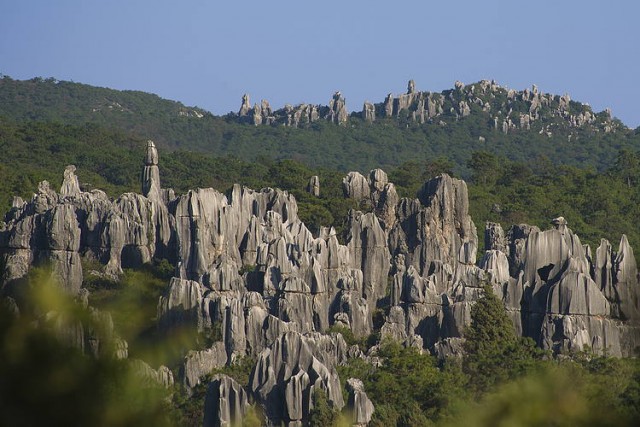karst
KARST IS A TERRAIN characterized by sinkholes, caves, and disappearing streams that have been created by chemical weathering in thick carbonate bedrock. Karst is named for the Krs Plateau along the ADRIATIC SEA and comes from an old Slavic word meaning “barren land.”
In the karst hydrologic cycle, moving water slowly dissolves away the limestone at and below the surface of the Earth, creating bumpy surface features and subsurface cavern systems. Landscapes generally appear pockmarked and gently rolling. Sinkholes or surface depressions are created when the roof of an underground cavity becomes thin and collapses under the weight of overlying beds. Sinkholes are visible at the surface and usually resemble small lakes and ponds. Some of them are steep-sided and deep, while others are minor dents in the land and relatively shallow. Some sinkholes fill with soil eroded from nearby slopes and are barely distinguishable. As sinkholes grow in size and abundance, cavern ceilings often collapse, thus exposing broad, flat-floored valleys.

Hydrogeologists cannot yet predict the location and timing of sinkhole creation. The dissolution of underground limestone creates honeycombs of caves columned with stalactites and stalagmites, generally circuitous and extending for miles. Streams run underground over long distances and are usually periodic at the surface, gushing up only in the event of heavy rains. Some cave patterns are dendritic or treelike; others have intersecting joints or meander like streams. Springs are a common feature in the karst areas, and because of their cool and constant temperatures, they have unique plant and animal life such as watercress, flatworms, and snails. Karst regions typically have caves in all stages of evolution, from water-filled holes to mature caves with large passageways and sporadic water flow. In order for karst to appear, limestone formations must contain at least 80 percent calcium carbonate, be aerated, and have joints for water to flow.
Karst regions are found throughout the world and cover about 15 percent of the Earth's land area. The most notable examples are the Mammoth Cave region of KENTUCKY; Dalmatia, along the ADRIATIC SEA; the haystack hills of CUBA, PUERTO RICO, southern CHINA; JAPAN; the Yucatan Peninsula of MEXICO; the MISSOURI Ozarks; INDIANA; NEW MEXICO; and northern and central FLORIDA. In Florida, karst is associated with the largest artesian system in North America. Artesian springs abound and are often the source of rivers. Silver Springs, Florida, discharges nearly half a billion gallons of water daily, the largest known artesian outflow in the world. Some parts of the Florida artesian system discharge on the sea floor at considerable distances from shore. With a consistently high water table, the caverns of Florida karst are typically filled with water and the sinkholes are lakes. In fact, there are so many sinkholes in central Florida that the region is called “the lake district.”
In Missouri, “the cave state,” the Division of Geology and Land Survey has counted more than 5,000 caves. Most of them are dolomite or limestone and some of them run more than 15 miles. Mammoth Cave in Kentucky is the longest cave in the world (350 mi or 560 km); almost 40 percent of Kentucky has karst features. Tower karst in China is composed of resistant blocks of rock that extend up 660 ft (200 m).
Caves have been utilized by human beings since ancient times, some as human burial places, others as hiding places and storage sites for furs, metals, alcohol, and food supplies. More than two dozen caves underlay the city of St. Louis, and historically many of them were used as underground breweries, saloons, beer gardens, and storage areas. Today karst topography poses serious hazards for construction and settlement. Chasms can suddenly appear and swallow entire houses and sections of highway.
Because the bedrock is unstable and cavernous, homes in karst regions are generally built without basements, and highways and cemeteries must be sited with care. Subsidence along a line of sinkholes and cavern collapse can quickly render an area off limits to human development. Sinkholes become repositories for everything from kitchen trash to bulldozers and thus become serious and elusive environmental challenges. Sinkhole contaminants flow with the water underground and travel far afield along the labyrinth of pathways, making cleanup virtually impossible.